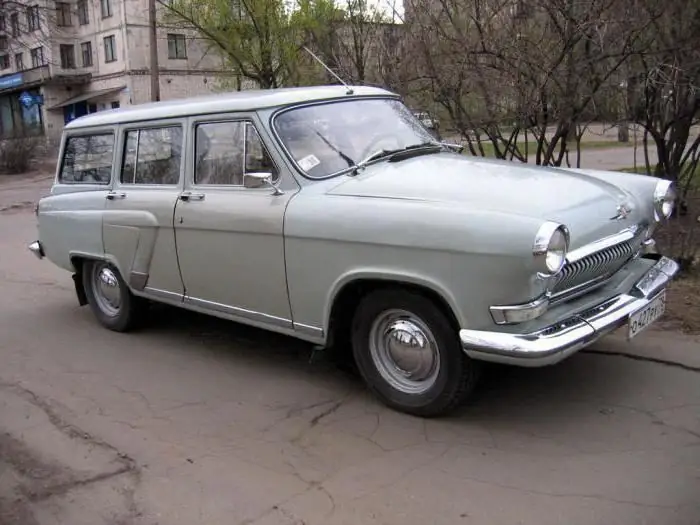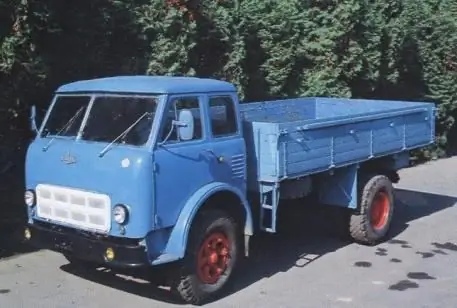2025 Author: Erin Ralphs | [email protected]. Last modified: 2025-01-22 21:14:16
Gorky Automobile Plant is known for its trucks. The seemingly ordinary rear-wheel drive GAZ-51 has become a legend in the domestic auto industry. The all-wheel drive GAZ-63 has undeservedly remained in the memory of only amateurs, and historians do not spoil it with attention.
Beginning of the history of creation
The famous GAZ-AA lorry was the only truck in the last decade before the Great Patriotic War. It was already outdated both morally and technically and required replacement. The army was in dire need of a four-wheel drive off-road truck.

At the beginning of 1938 at the Gorky Automobile Plant. Molotov, work began on the creation of a whole series of trucks designed for difficult road conditions. Two- and three-axle all-wheel drive truck chassis differed mainly in the length of the base.
The first domestic all-wheel drive car GAZ-63 began its history in April 1938. A year later, the first prototypes were built, whichoriginally called GAZ-62. They were equipped with upgraded engines from a GAZ-MM lorry with a capacity of 50 hp. With. The cab was used from a GAZ-415 pickup truck, and the undercarriage was developed specifically for this model.
Design features
The development of a new cabin design was not involved. The main objective was to create an all-terrain vehicle, so attention was paid to the running gear.
A fundamentally different layout - the engine was located above the front axle - made it possible to increase the load capacity while reducing the base length.
For the first time, single wheels were installed with the same front and rear track, they were all leading, while for the sake of fuel economy, front-wheel drive could be turned off. Dual rear wheels, which are forced to widen the trail in sand and mud, result in excess power consumption. The transfer case was installed so that the length of the cardan shafts to both the front and rear axles was the same. The dependent suspension of all wheels was located on semi-elliptical springs, and the front one still had double-acting hydraulic shock absorbers. The hand brake drive has become hydraulic.
In early 1943, the cabin and engine were changed on the car. With a cabin from Studebaker, it lasted until the end of Lend-Lease deliveries.
The production of this car was resumed in 1948 with a cab from GAZ-51. The overall dimensions of the GAZ-63 in the updated version were 5525×2200×2245 mm.
Vehicle-based military equipment
In October 1943 at the Gorky Automobile Plantbegan to develop a wheeled self-propelled gun with a 76 mm caliber gun. By May 1944, the first copy was released. On both sides of the gun were the driver's and gunner's seats. Ammunition consisted of fifty-eight shells. This car fought at the end of World War II.
In parallel with the development of a truck model on its basis in 1947, a light two-axle armored personnel carrier with a load-bearing body was developed, called the BTR-40. The armored personnel carrier was designed for eight paratroopers. The wheelbase has decreased by 600 mm, the engine power has been raised to 81 hp. s., increasing the upper limit of the rotational speed and sacrificing durability, which did not matter much for military equipment.

The armored personnel carrier was armed with a heavy machine gun of the Goryunov system, which included 1260 rounds of ammunition. The machine gun could be mounted along the sides on one of four brackets. On the same brackets, it was possible to install the PDM light machine gun, which the paratroopers were armed with. Modification of the BTR-40A was equipped with coaxial heavy machine guns KVPT. In 1993, the armored personnel carrier was decommissioned.
The BM-14 "Katyusha" rocket artillery fighting vehicle has been produced since 1950 on the GAZ-63 chassis.
Serial production
From the beginning of the fall of 1948, mass production of the GAZ-63 began. By that time, he successfully confirmed the characteristics by state tests, during which climbs up to 30 °, fords up to 0.9 m and ditches up to 0.76 m deep were overcome. Consumption of the cheapest gasoline A-66ranged from 25 to 29 liters per 100 km, carrying capacity on the highway - 2.0 tons, on a dirt road - 1.5 tons.
A significant drawback of this car was the instability in high-speed corners. The ground clearance was 270 mm with a narrow track, it increased the truck's cross-country ability, but at the same time, an increase in height led to a rollover on corners and slopes. This was especially true for high-end special equipment on the GAZ-63 chassis, for example, vans or tanks.

In the summer of 1968, the last such production car was produced. For all the time, 474 thousand cars of various modifications were produced. They were exported to the countries of the socialist camp, Finland, the Middle East, Asia and Africa.
Export deliveries
GDR, Poland, Czechoslovakia and Yugoslavia in Eastern Europe, Vietnam, North Korea, Laos and Mongolia in Asia, Cuba, African countries - the states to which the GAZ-63 was supplied. Export cars were underpriced. The equipment was supplied as part of fraternal assistance to friendly countries.
Not only the basic models of the GAZ-63 and 63A all-wheel drive truck, but also its modifications 63P in export and tropical versions, vehicles with shielded equipment 63E, buses on this chassis and other models were delivered abroad.
In addition, in North Korea since 1961 under the brand name Sungri-61 Sungri-61NA and in China since 1965 under the brand name Yuejin NJ230 and NJ230A, cars based on this car were produced under the Soviet license.

Bcombat operations in the DPRK, the Soviet all-wheel drive army truck proved to be a real combat vehicle and earned the recognition of the military.
Army vehicle
Until 1950, the cabin of the car was wooden, then metal with wooden doors, and since 1956 - all-metal. It was cramped and cold, the heater in the design appeared only in 1952, despite the fact that preheaters were installed in cars from the beginning of production.
The cargo-passenger platform with high lattice plank sides was equipped with folding longitudinal benches for transporting soldiers. The tailgate was hinged. An awning protected from bad weather, which was stretched on four arcs installed in special nests. The height of the car on the awning was 2,810 mm.

Improved the functionality of the car and the fact that it could tow trailers with a carrying capacity of two tons.
The GAZ-63 army off-road truck was used to transport personnel, to tow guns, and to mount combat installations.
Off-road modifications
There were only two main modifications of the off-road truck.
In parallel with the base model, a modification was produced with a winch at the front end of the GAZ-63A elongated frame for self-pulling and helping other vehicles in difficult road conditions. The winch with a cable 65 m long was driven by a cardan shaft through the power take-off from the transmission and developed a pulling force of up to 4.5 tons. Curb weightvehicle is 240 kg more than the base model.

In 1958, the GAZ-63P tractor was produced with reduced wheels to work with a single-axle semi-trailer with a carrying capacity of up to four tons. The rear wheels of the tractor were already gable. And from next year, the plant began to produce the GAZ-63D truck tractor. Its design, unlike the previous modification, included a power take-off and a mechanical output to drive the tipper mechanism in the semi-trailer design.
Special vehicles based on SUV
Fuel tankers, oil tankers, milk tanks, vans, mobile auto repair shops, staff and medical buses, disinfection units, auger-rotary machines were assembled on the basis of GAZ-63. The fire communication and lighting vehicle, tank trucks of several modifications were produced by the Vargashinsky plant of fire-fighting equipment. Staff and sleeve fire trucks were produced at the Moscow plant of fire engines.

For the military, in addition to basic models, staff and medical buses, shielded warm and sealed communication vehicles, disinfection and shower installations DDA-53A were produced for sanitizing personnel in the field, disinfecting and disinsection of uniforms and equipment. The installation was equipped with a steam boiler for liquid fuel or wood, the working pressure of which was four atmospheres, a storage boiler, a hand pump, a steam elevator, control equipment, two open disinfection chambers and shower cabins with twelveshower screens.
Specifications
Since the GAZ-51 civilian truck was created at the plant almost simultaneously with the army one, most of the units and parts were unified, which made it possible to assemble these vehicles on the same conveyor over time, thereby reducing the cost of assembly and simplifying operation.
The engine on the army SUV was installed from the GAZ-51 six-cylinder carburetor lower valve with a volume of 3.5 thousand cubic meters. see Small power reserve of 70 liters. With. and a speed of 65 km/h were compensated by a cruising range with a full load without refueling of 780 km.

Two fuel tanks, main and additional, gave a fuel supply of almost 200 liters of gasoline. GAZ-63 (diesel) appeared in various home-made versions and is still being finalized by craftsmen.
The gearbox in this car is four-speed, the clutch is single-disk, dry, in the transfer case there are two steps and a demultiplier, which is equipped not only with a reduction gear, but also with a direct gear to reduce fuel consumption on highways.
GAZ-63 was hardy, unpretentious and easy to operate, had high cross-country ability, thanks to these characteristics it was produced for almost twenty years. It can be found even now not only among amateurs - from conservation, at competitions, but also on the roads. Its price fluctuates in the car market from 60 to 450 thousand rubles, depending on the condition and availability of native parts and assemblies.
Recommended:
Soviet car GAZ-22 ("Volga"): description, specifications, photos

The GAZ-22 is known to the general public as a station wagon. The series was produced at the Gorky plant from 1962 to 1970. In the cabin, 5-7 people could easily fit due to the transformation of the seats. The body was made of a special material that formed the supporting structure. During the entire production period, several types of cars were created. The GAZ model range at one time was able to completely surprise domestic buyers
GAZ 3307 - favorite Soviet truck

The GAZ 3307 truck (popularly known by the nickname "Lawn") was put into production at the end of 1989. It is produced to this day. During this considerable period of time, many models and modifications of machines were built on its basis, including the Valdai GAZ, which had a "Lazon" frame and a "Gazelle" cabin. In fact, model 3307 was the fourth generation of the legendary GAZON, whose history begins back in the distant 60s
"MAZ 500", truck, dump truck, timber truck

The Soviet truck "MAZ 500", the photo of which is presented on the page, was created in 1965 at the Minsk Automobile Plant. The new model differed from its predecessor "MAZ 200" in the location of the engine, which was placed in the lower part of the cab. This arrangement allowed to reduce the weight of the car
KrAZ 214: the history of the creation of an army truck, specifications

Work on the project of a new cargo tractor began in 1950. The car was assigned the YAZ-214 index, which in 1959, after the transfer of the production of trucks from Yaroslavl to Kremenchug, was changed to KrAZ-214
Soviet motorcycle "Tula": history, description, characteristics

Tula is associated with gingerbread and samovars for many. But adult motorcyclists still remember the Tulitsa scooters, which were distributed throughout the country, and the Tula motorcycle, which is ridiculous in today's perception. This off-road motorcycle is a domestic development

